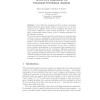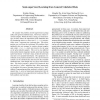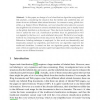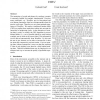COLT
2007
Springer
14 years 5 months ago
2007
Springer
In the multi-view regression problem, we have a regression problem where the input variable (which is a real vector) can be partitioned into two different views, where it is assum...
IJCNN
2008
IEEE
14 years 5 months ago
2008
IEEE
Abstract— This paper proposes an approach to learn subjectindependent P300 models for EEG-based brain-computer interfaces. The P300 models are first learned using a pool of exis...
ICDM
2008
IEEE
14 years 5 months ago
2008
IEEE
We consider the problem of Semi-supervised Learning (SSL) from general unlabeled data, which may contain irrelevant samples. Within the binary setting, our model manages to better...
DASFAA
2008
IEEE
14 years 6 months ago
2008
IEEE
In this paper, we design a local classification algorithm using implicit link analysis, considering the situation that the labeled and unlabeled data are drawn from two different ...
ICDAR
2009
IEEE
14 years 6 months ago
2009
IEEE
Training a system to recognize handwritten words is a task that requires a large amount of data with their correct transcription. However, the creation of such a training set, inc...
PAKDD
2009
ACM
14 years 6 months ago
2009
ACM
In this paper we propose to study budget semi-supervised learning, i.e., semi-supervised learning with a resource budget, such as a limited memory insufficient to accommodate and/...
MCS
2009
Springer
14 years 6 months ago
2009
Springer
Abstract. Semi-supervised learning and ensemble learning are two important learning paradigms. The former attempts to achieve strong generalization by exploiting unlabeled data; th...
SDM
2009
SIAM
14 years 8 months ago
2009
SIAM
The annotation of words and phrases by ontology concepts is extremely helpful for semantic interpretation. However many ontologies, e.g. WordNet, are too fine-grained and even hu...
KDD
2002
ACM
14 years 12 months ago
2002
ACM
An adaptive semi-supervised ensemble method, ASSEMBLE, is proposed that constructs classification ensembles based on both labeled and unlabeled data. ASSEMBLE alternates between a...
KDD
2008
ACM
14 years 12 months ago
2008
ACM
Traditional spectral classification has been proved to be effective in dealing with both labeled and unlabeled data when these data are from the same domain. In many real world ap...




